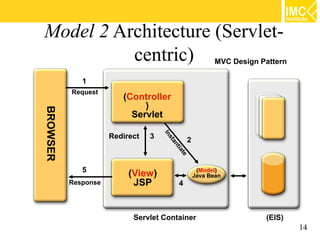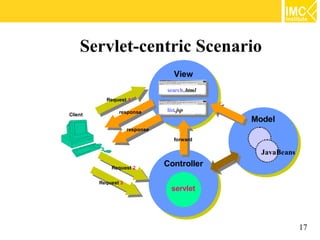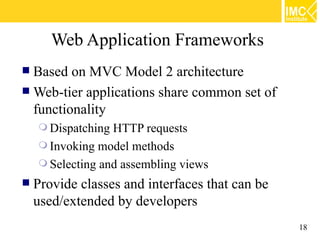Java Web Programming [6/9] : MVC
- 1. Module 6: MVC Thanisa Kruawaisayawan Thanachart Numnonda www.imcinstitute.com
- 2. Objectives Introduction of MVC pattern Evolution of Web Application design architecture Model 1 Model 2 Application frameworks 2
- 3. MVC Pattern 3
- 4. Three Logical Layers in a Web Application: Model Model (Business process layer) Models the data and behavior behind the business process Responsible for actually doing Performing DB queries Calculating the business process Processing orders Encapsulate of data and behavior which are independent of presentation 4
- 5. Three Logical Layers in a Web Application: View View (Presentation layer) Display information according to client types Display result of business logic (Model) Not concerned with how the information was obtained, or from where (since that is the responsibility of Model) 5
- 6. Three Logical Layers in a Web Application: Controller Controller (Control layer) Serves as the logical connection between the user's interaction and the business services on the back Responsible for making decisions among multiple presentations e.g. User's language, locale or access level dictates a different presentation. A request enters the application through the control layer, it will decide how the request should be handled and what information should be returned 6
- 7. Web Applications It is often advantageous to treat each layer as an independent portion of your application Do not confuse logical separation of responsibilities with actual separation of components Some or of the layers can be combined into single components to reduce application complexity 7
- 8. Evolution of MVC Architecture 1.No MVC 2.MVC Model 1 (Page-centric) 3.MVC Model 2 (Servlet-centric) 4.Web application frameworks Struts 1.Standard-based Web application framework JavaServer Faces (JSR-127) 8
- 9. Evolution of Web Application Design until Model 1 Architecture No MVC Model 1 architecture 9
- 10. Model 1 Architecture (Page-centric) 1 Request JSP 4 pages BROWSER Response 2 Java 3 Bean Servlet Enterprise Container Information Systems (EIS) 10
- 11. Page-centric Architecture Composed of a series of interrelated JSP pages – JSP pages handle all aspects of the application - presentation, control, and business process Business process logic and control decisions are hard coded inside JSP pages in the form of JavaBeans, scriptlets, expression Next page selection is determined by – A user clicking on a hyper link, e.g. <A HERF="find.jsp> – Through the action of submitting a form, e.g. <FORM ACTION="search.jsp"> 11
- 12. Page-centric Architecture memu.jsp catalog.jsp checkout.jsp dataBase page–centric catalog application 12
- 13. Page-centric Scenario View search.html Request 1 response list.jsp Client Model response forward JavaBeans Request 2 Controller Request 3 find.jsp redirect delete.jsp 13
- 14. Model 2 Architecture (Servlet- centric) MVC Design Pattern 1 Request (Controller ) BROWSER Servlet Redirect 3 In 2 st an tia te 5 (Model) (View) Java Bean Response JSP 4 Servlet Container (EIS) 14
- 15. Why Model 2 Architecture? What if you want to present different JSP pages depending on the data you receive? JSP technology alone even with JavaBeans and custom tags (Model 1) cannot handle it well Solution Use Servlet and JSP together (Model 2) Servlet handles initial request, partially process the data, set up beans, then forward the results to one of a number of different JSP pages 15
- 16. Servlet-centric Architecture JSP pages are used only for presentation Control and application logic handled by a servlet (or set of servlets) Servlet serves as a gatekeeper – Provides common services, such as authentication, authorization, login, error handling, and etc Servlet serves as a central controller – Act as a state machine or an event dispatcher to decide upon the appropriate logic to handle the request – Performs redirecting 16
- 17. Servlet-centric Scenario View search.html Request 1 response list.jsp Client Model response forward JavaBeans Request 2 Controller Request 3 servlet 17
- 18. Web Application Frameworks Based on MVC Model 2 architecture Web-tier applications share common set of functionality Dispatching HTTP requests Invoking model methods Selecting and assembling views Provide classes and interfaces that can be used/extended by developers 18
- 19. Why Web Application Framework? De-coupling of presentation tier and business logic into separate components Provides a central point of control Provides rich set of features Facilitates unit-testing and maintenance Availability of compatible tools Provides stability Enjoys community-supports Simplifies internationalization Simplifies input validation 19
- 20. Why Web Application Framework? Frameworks have evolved with Java Server technology JSP/Servlets are still hard to use Frameworks define re-usable components to make this job easier. A good framework defines how components work to create a usable application. 20
- 21. Web Application Frameworks Apache Struts JavaServer Faces (JSR-127) A server side user interface component framework for JavaTM technology-based web applications Echo Tapestry 21
- 22. Acknowledgement Most contents are borrowed from the presentation slides of Sang Shin, Java™ Technology Evangelist, Sun Microsystems, Inc. 22
- 23. Thank you thananum@gmail.com www.facebook.com/imcinstitute www.imcinstitute.com 23























